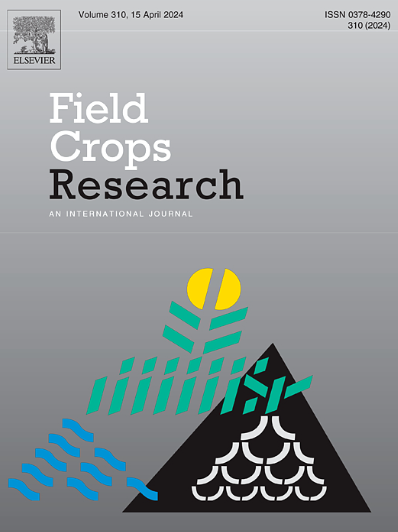Co-application of microalgae and biochar increases yield and mitigates greenhouse gas emissions in saline-alkali soil
IF 5.6
1区 农林科学
Q1 AGRONOMY
引用次数: 0
Abstract
Context
Despite the proven role of biochar or microalgae application alone in yield stability and climate resilience, their synergistic effects have not been well characterized, especially in fragile saline-alkali lands.
Objective
This study aims to investigate the individual and combined effects of biochar and microalgae application on sunflower yield, soil carbon (C), greenhouse gas (GHG) emissions, and carbon footprint (CF), providing novel insights into saline-alkali soil management.
Method
Three doses of microalgae fertilizer (0, 30, and 60 L ha−1), combined with two rates of biochar (0 and 30 t ha−1), were applied in field experiments over 3 years in Northwest China (Wuyuan, Inner Mongolia). The key parameters evaluated included the soil organic carbon (SOC) content, GHG emissions, and crop yield.
Results
Microalgal fertilizer application alone caused minimal changes in SOC storage, whereas biochar application had a predominant effect, indicating that biochar was a key contributor to SOC accumulation. Notably, the combined effects of biochar and microalgae on yield, SOC storage, and emission reduction were stronger than those of each factor separately, confirming the positive complementary effects of dual application. The combination of microalgae fertilizer and biochar resulted in maximum yield (3824 kg ha−1) and SOC sequestration (26 Mg C ha−1), which increased by 58 % and 24 %, respectively, compared to that of the control over the three years. Additionally, co-application reduced GHG emissions and the CF by 18 %-31 % and 101 %, respectively.
Conclusion
The combination of 30 t ha⁻¹ biochar and 60 L ha⁻¹ microalgae was identified as the optimal strategy for the study area. This optimized regime holds great potential for increasing crop yield, enhancing C sequestration, and mitigating GHG emissions, thereby promoting sustainable development in saline agriculture.
在盐碱地中,微藻与生物炭混施可提高产量,减少温室气体排放
尽管生物炭或微藻单独施用在产量稳定性和气候适应性方面的作用已得到证实,但它们的协同效应尚未得到很好的描述,特别是在脆弱的盐碱地。目的研究生物炭和微藻单独及联合施用对向日葵产量、土壤碳(C)、温室气体(GHG)排放和碳足迹(CF)的影响,为盐碱地管理提供新思路。方法在内蒙古婺源进行了3年的微藻肥(0、30和60 L ha−1)和2种生物炭(0和30 t ha−1)的田间试验。评估的关键参数包括土壤有机碳(SOC)含量、温室气体排放和作物产量。结果单独施用微藻肥对土壤有机碳储量的影响较小,而施用生物炭对土壤有机碳储量的影响最大,表明生物炭是土壤有机碳积累的主要贡献者。值得注意的是,生物炭和微藻对产量、碳储量和减排的联合效应强于单独施用,证实了双施用的正互补效应。与对照相比,微藻肥与生物炭配施3年内产量最高(3824 kg ha−1),固碳量最高(26 Mg C ha−1),分别提高了58 %和24 %。此外,共施可使温室气体排放量和CF分别减少18 %-31 %和101 %。结论30个 L ha⁻¹ 生物炭和60个 L ha⁻¹ 微藻的组合是研究区域的最佳策略。这一优化机制在提高作物产量、加强碳固存和减少温室气体排放方面具有巨大潜力,从而促进盐碱地农业的可持续发展。
本文章由计算机程序翻译,如有差异,请以英文原文为准。
求助全文
约1分钟内获得全文
求助全文
来源期刊

Field Crops Research
农林科学-农艺学
CiteScore
9.60
自引率
12.10%
发文量
307
审稿时长
46 days
期刊介绍:
Field Crops Research is an international journal publishing scientific articles on:
√ experimental and modelling research at field, farm and landscape levels
on temperate and tropical crops and cropping systems,
with a focus on crop ecology and physiology, agronomy, and plant genetics and breeding.
 求助内容:
求助内容: 应助结果提醒方式:
应助结果提醒方式:


